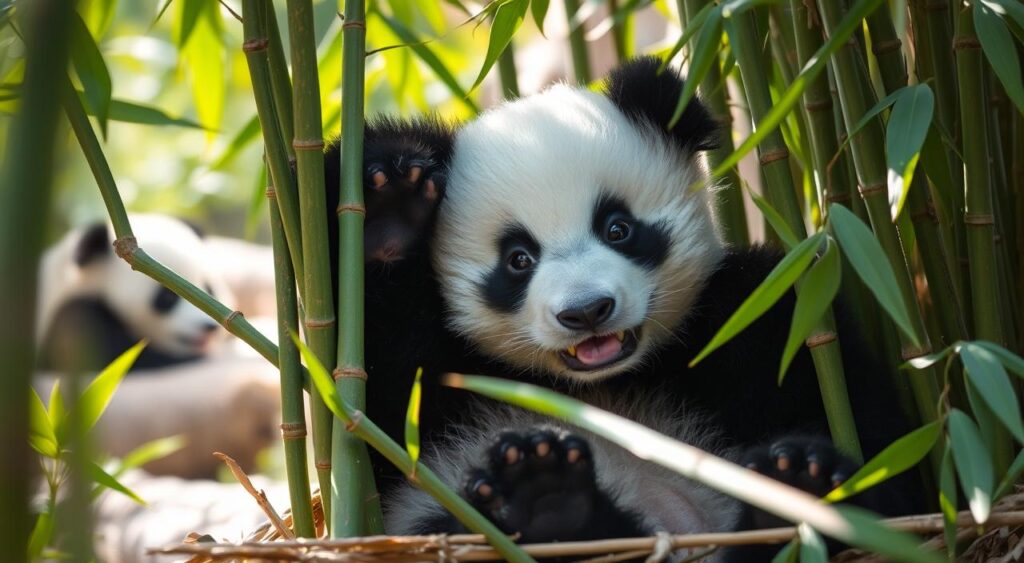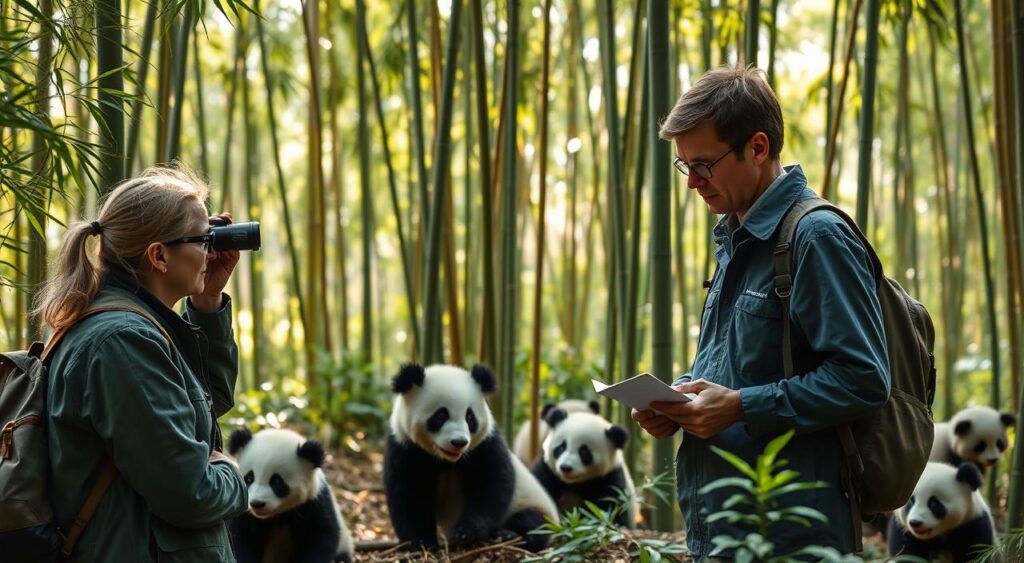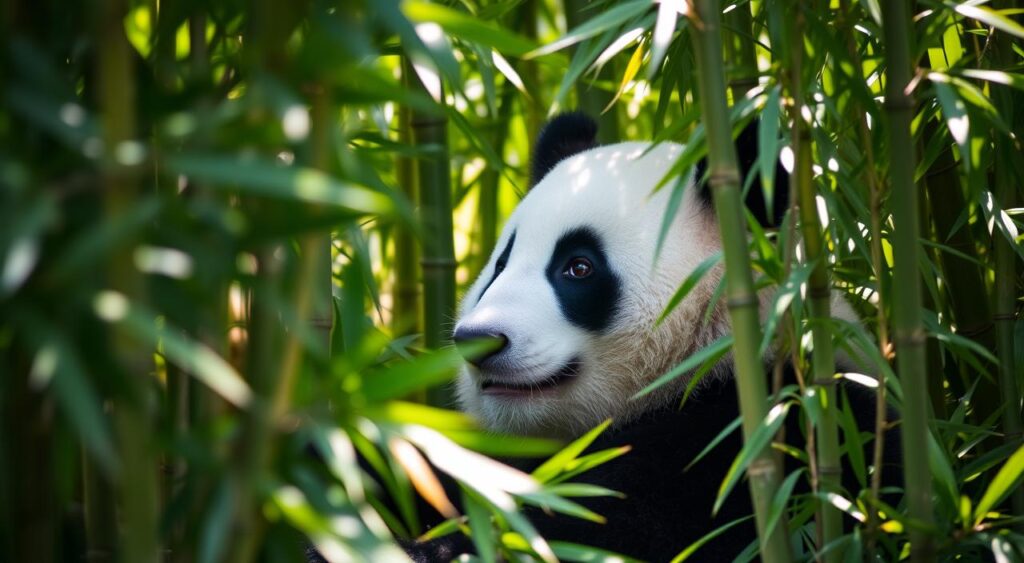Pandas are loved worldwide for their black and white fur and cute looks. Saving these endangered animals is hard, but breeding programs help a lot. This article will look into panda breeding, the challenges, and how scientists and groups work together.
We’ll see how they breed pandas in captivity and protect their homes. It’s a big effort to save these amazing animals.
Key Takeaways
- The giant panda population in the wild is estimated to be only around 1,600, with an additional 600 pandas in captivity worldwide.
- Panda breeding programs have faced unique challenges, including the species’ low birth rate and narrow breeding window.
- Advancements in reproductive science, such as artificial insemination, have led to successful births of giant pandas in captivity.
- International collaboration between organizations like the Smithsonian and China’s wildlife conservation agencies has been crucial for panda conservation efforts.
- Habitat preservation and restoration are vital to ensure the long-term survival of the giant panda in its natural environment.
Introduction to Panda Breeding
The giant panda, known as Ailuropoda melanoleuca, is a unique animal. They have black and white fur and are loved by many. But, breeding them is challenging due to their biology and behavior.
Uniqueness of Pandas
Pandas have a low reproductive rate. Females only ovulate once a year. They also eat mostly bamboo, which is hard to digest.
This makes panda breeding programs crucial for their survival. Their habitat is also being destroyed, adding to the problem.
Challenges in Breeding
Scientists face many challenges when breeding pandas. They need new research and international help. They have made progress in captive breeding, like artificial insemination.
But, they still face issues like low birth rates and high cub mortality. This makes it hard to have a successful captive breeding program.
| Key Panda Breeding Statistics | Value |
|---|---|
| Largest ex-situ conserved population of captive giant pandas | 244 individuals |
| Largest population of captive red pandas | 160 individuals |
| Science popularization education events organized | Over 3,000 |
| Visitors to the Panda Base in a year | Over 9 million |
Despite the challenges, conservation efforts in China have saved the giant panda. The work of researchers and conservationists has been key. They have helped keep this vulnerable species alive.
History of Panda Conservation in China

The story of panda conservation in China is filled with challenges and great progress. The Chinese government started protecting these iconic creatures in the early 20th century. They knew the giant panda, found only in China, needed help.
Early Efforts and Challenges
In the 1970s, a census found about 2,459 pandas in the wild. But by the mid-1980s, that number dropped to 1,114. This big drop showed how urgent it was to act.
Protecting the giant panda was tough from the start. Poaching, losing their homes, and not knowing enough about pandas made it hard. These issues made it hard to start successful breeding programs.
Establishment of Reserves and Breeding Centers
In the late 1980s and 1990s, China took big steps to save the giant panda. They made a network of protected areas. The Chengdu Research Base of Giant Panda Breeding was started in 1987 to help pandas in captivity.
By the late 1990s, 467 pandas had been kept in captivity since 1936. The Panda Studbook showed 28% of adult pandas in captivity were breeding. Also, 12 captive-born pandas had made it to one year.
International help made a big difference. In 1994, China let pandas be sent to other countries for breeding. This led to the first long-term joint breeding studies between China and foreign zoos.
Today, there are over 600 captive-bred giant pandas worldwide. The Chengdu Research Base of Giant Panda Breeding is a key player. It grew from six pandas in the 1980s to 206 by 2019.
Panda Breeding Programs

Panda breeding programs are key to saving the giant panda. Over time, scientists have improved how they breed pandas in captivity. They use new methods like artificial insemination and hormone checks to help pandas have babies.
Captive Breeding Techniques
Scientists have made big strides in breeding pandas in captivity. They now know a lot about panda biology and behavior. This knowledge helps them create better breeding conditions, making it more likely for pandas to have babies.
Artificial insemination is especially helpful when pandas don’t want to mate or have trouble reproducing. The Chengdu Research Base of Giant Panda Breeding in China’s Sichuan province leads in these efforts. They work with international partners to breed and care for captive pandas.
Role of International Collaboration
International teamwork has greatly helped panda conservation. Places like the Smithsonian’s National Zoo and Conservation Biology Institute in the U.S. work closely with Chinese wildlife groups. They share research, train experts, and support conservation together.
This global partnership has led to the exchange of important data and training. It has also helped increase the number of giant pandas worldwide. This is crucial for the survival of this vulnerable species.
“The worldwide captive population of giant pandas reached approximately 600 individuals by the end of 2019, thanks to the success of international collaboration and captive breeding programs.”
Scientific Research in Panda Conservation

Scientific research is key to saving the giant panda. Researchers are working hard to learn more about these amazing animals. They study the giant panda’s biology and behavior to improve breeding and reintroduction programs.
Understanding Panda Biology and Behavior
Scientists have done a lot of research on the giant panda. The Fourth National Giant Panda Survey in 2015 gave us important information. They found out about the species’ population and where they like to live.
They also looked into how pandas choose their homes and how humans affect their space. This helps us understand how to protect their homes better.
Advances in Reproductive Science
Reproductive science has made big steps forward in breeding pandas. Scientists have learned a lot about artificial insemination and how pandas reproduce. This helps pandas in captivity have healthy babies.
Genetic studies are also important. They help scientists know who the father of a panda cub is. This keeps the genetic diversity of pandas in captivity strong.
Researchers are very dedicated and creative. Their hard work is making a big difference in saving the giant panda. Thanks to them, the future of the giant panda looks brighter than ever.
“The first giant panda genome assembly, conducted in collaboration with Chinese colleagues, has been a game-changer in our understanding of this species. It has allowed us to identify paternity for many panda cubs and study the effects of habitat loss on panda population size.”
Habitat Preservation and Restoration

Alongside the advancements in panda breeding programs, habitat preservation and restoration are key parts of panda conservation efforts in China. The giant panda’s natural habitat, the bamboo forests of central China, face threats from human activities like deforestation and development. This has led to the fragmentation and loss of these vital ecosystems.
To fight this threat, the Chinese government has launched various conservation initiatives. These aim to protect and restore the giant panda’s natural habitat. Some of these efforts include:
- Creating national parks and nature reserves to safeguard the remaining bamboo forests.
- Starting reforestation programs to rebuild and reconnect broken habitats.
- Working with local communities to promote sustainable land-use practices and reduce human-wildlife conflict.
- Using advanced monitoring and tracking technologies to better understand and protect the wild panda population.
These habitat conservation efforts are crucial for the long-term survival of the giant panda. This vulnerable species is still threatened by habitat loss and fragmentation. By preserving and restoring the bamboo forests, conservationists aim to secure the future of this iconic species and the entire ecosystem it supports.
Public Engagement and Education

The giant panda has won the hearts of people everywhere, becoming a symbol for conservation. China’s panda breeding programs see the value in engaging the public and educating them. This helps support efforts to save this endangered species.
Panda Diplomacy
“Panda diplomacy” is key to China’s conservation plan. By sharing pandas with other countries, China builds global partnerships. It also raises awareness about the need to protect the panda’s home.
This cultural exchange helps get funding and resources for conservation. It’s a big step in saving the giant panda.
Training Future Conservationists
To keep panda conservation going, places like the Chengdu Research Base have started education programs. These programs teach the next generation of conservationists. They learn through hands-on experiences and workshops.
The Panda Base has a team of 32 people focused on education and science. They include 23 science teachers and 1 foreign expert. The base’s 233.33-hectare park draws millions of visitors each year. It’s a chance to teach people about panda conservation.
The Panda Base has places like the Giant Panda Museum and Panda Story Cinema. These venues help people understand and love pandas. They also train future leaders in conservation.
The Panda Base’s work in education and outreach is key to saving the giant panda. It inspires and empowers people worldwide. This is crucial for the panda’s survival and its habitat’s health.
Also Read: How You Can Support Panda-Friendly Environmental Policies
Conclusion
The giant panda’s conservation is a big challenge. It needs a mix of science, breeding programs, saving habitats, and getting people involved. Thanks to protected areas and breeding centers, the panda’s numbers are slowly going up. By October 2014, there were 397 pandas in captivity worldwide.
But, there are still big hurdles. The captive pandas mostly come from a few places, leaving others like Daxiangling behind. Inbreeding is a problem, leading to lower fertility and survival rates. This shows we need to manage breeding carefully and focus on the right habitats.
Science has helped a lot in understanding pandas. We now know more about their biology, behavior, and how to breed them. Knowing things like who makes a good mate and how past litters affect future ones helps us breed better. Keeping up with science, saving habitats, and engaging the public are key to saving the giant panda for good.
FAQs
Q: What is the purpose of the research center for the giant panda?
A: The research center for the giant panda focuses on the conservation and breeding of giant pandas, aiming to increase their population and ensure their survival, thus preventing extinction.
Q: How do researchers determine the pregnancy of female pandas?
A: Researchers use non-invasive methods such as ultrasound to confirm pregnancy in female pandas, allowing them to monitor the health of the embryo and the mother.
Q: What role do researchers play in helping mother pandas take care of their offspring?
A: Researchers help mother pandas by providing assistance during the rearing process, ensuring that the mother has the necessary support and resources to care for her baby pandas effectively.
Q: What is the significance of the success of captive breeding programs for giant pandas?
A: The success of captive breeding programs is crucial for increasing the population of giant pandas, allowing for more controlled breeding and the possibility of reintroducing healthy bears into the wild.
Q: Can you explain the process of natural mating in female giant pandas?
A: Natural mating involves the female giant pandas displaying interest in mating, which is determined by hormonal changes. If successful, this can lead to pregnancy and the birth of baby pandas.
Q: What challenges do researchers face in establishing a successful panda breeding program?
A: Challenges include managing the reproductive success of female pandas, dealing with issues like embryonic diapause, and ensuring genetic diversity through the careful selection of semen for artificial insemination.
Q: Where are some of the leading centers for panda breeding located in China?
A: Some of the leading centers include the China Conservation and Research Center for the Giant Panda, the Bifengxia Giant Panda Base, and the Chengdu Research Base of Giant Panda Breeding.
Q: How do researchers assess the health of a panda pregnancy?
A: Researchers assess the health of a panda pregnancy through regular ultrasounds and hormonal monitoring, which helps them confirm the development of the embryo and the overall health of the mother panda.
Q: What happens when a baby panda is born in captivity?
A: When a baby panda is born in captivity, researchers closely monitor its health and development, providing assistance to the mother panda and ensuring that the baby receives the necessary care for healthy growth.

